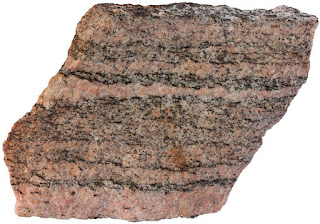p class="MsoNormal">Archean rocks are mainly composed of two types
of rocks:
Lithology:
gneiss
schist
GNEISS:
A rock with a banded or leafy structure,
typically coarse-grained and consisting mainly of feldspar, quartz, and mica.
The mineral composition varies from
granite to gabbro.
Gneiss is the most prominent common rocks of the Archaean
system. They range in composition from only slightly altered granite [igneous]
or a gabbro [igneous] to a banded or leafy, true gneiss
[metamorphic].
Common minerals of Archaean gneiss are: feldspar orthoclase and
plagioclase, quartz, muscovite, biotite, hornblende, magnetite, epidote and zircon.
The rocks of the Archaean system are often
divided into the following three groups which are usually represented in
certain regions:
i) Bengal Gneiss:
The highly heterogeneous Gneisses of
Bengal, Bihar and Orissa and many other parts of peninsular India are
include underthis group.This type of rock sometimes referred to as khondalite isactuallyeither sillimanite gneiss or sillimanite-schist.
ii) Bundelkhand Gneiss:
This group includes the large granites of Bundelkhand like
Gneiss and some other areaslike Balaghat, Arcot and Cuddapah. The most important characteristic of these gneisses is
that in hand specimens they appear as granite-leaf forms that are present on a
very small scale. In many places of their occurrence, coarse-grained igneous
rocks are infiltrated by mills and dams.
iii)Charnockite Series :
The range includes the vast, granite-like hypersthenes-
rich gneiss
of southern India, developed extensively in Madras. In their petrological
character, they are medium to coarse-grained and show mineral variation in the
acid to ultra basic range, although orthopyroxene (hypersthenes) is always a significant component.
The rock was
named because of its use in the tomb of the founder of the city of Calcutta,
Job Charnock.The type of rock recorded in many other parts of
the world presents a challenging problem in its origin.
It has been suggested
by some that the charnockites are actually of indigenous, plutonic origin
intruded into the older rocks of the Archaean group. These often occur as
igneous infiltrates of dikes, lenses .but other cases also show
prominent banding indicating substantial metamorphosis.
Some other typical gneisses of
the Archean group of rocks, exposed in different parts and mentioned with
specific names, are as follows;
Champion Gneiss:
It is exposed in Karnataka and has fine gray
gneiss with good mica content. It is at the sites of intrusion in Dharwar rocks.
The name is of restricted use. It is considered to be the earliest age of the
Archean era.
Peninsular Gneiss:
quartz-felsper(peninsular gnesis)

It is a common gneiss rock of Archaean age
occurring at various places in southern India including Karnataka. The rock
couscous consists mostly of banded gneiss, with bands of quartz-felser alternating
with biotite, hornblende, and other supporting minerals. Like champion gneiss,
these rocks are also infiltrating the rocks of Dharwar at
many places.
SCHIST:
Schistes are abundant in Archaean rocks, they are completely crystalline
and are found in many varieties such as mica-schists.
Hornblende-schist etc. A coarse-grained metamorphic rock consisting of layers
of different minerals and can be divided into thin irregular plates.
Contains mostly crystalline, mica, talc,
hornblende, chlorite, etc.
continue reading by clicking
follow us on instagram @deargeology❤






